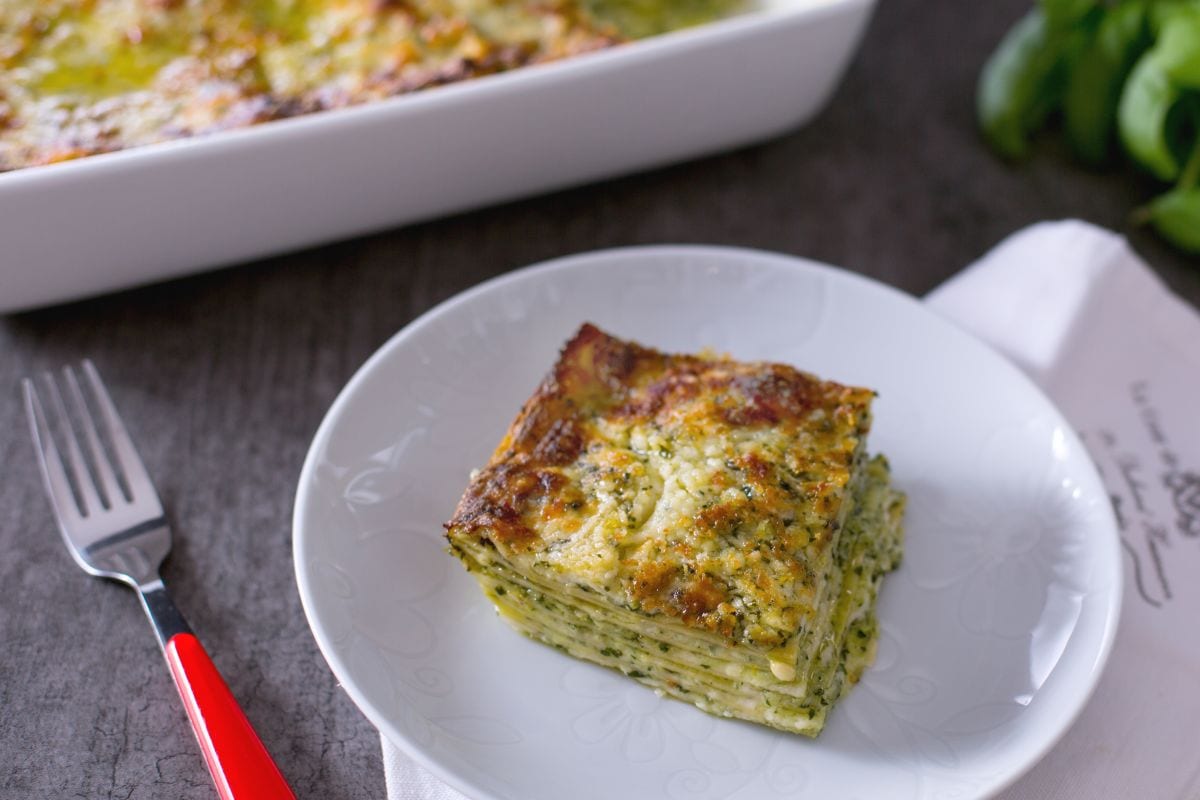Zucchini lasagna
- Average
- 1 h 50 min

Pesto lasagna is a special recipe in which two stars of our cuisine come together harmoniously in a first course of homemade pasta that evokes the flavors of tradition. Layers of handmade egg pasta sheets alternate with a tasty and strong Genoese pesto (basil sauce) to be prepared with the first leaves of basil offered by the season. The béchamel sauce, which gives a velvety touch and makes the sheets creamy, is a must in this dish. While a bit time consuming, pesto lasagna is a multiple-step process of homemade preparations that will repay you in terms of taste and the rewarding feeling of having done everything yourself! So dust off the mortar and rolling pin and get to work preparing this delicious summer dish.
What can you pair pesto with? Here are some further ideas:
Discover more delicious Lasagna recipes and elevate your cooking game!

To prepare pesto lasagna, start with the pesto (for the complete procedure you can see our Genoese pesto recipe): first off, clean the basil leaves with a clean cloth, do not wash them with water. Then take a mortar and pound the peeled garlic together with a pinch of coarse salt: once you have a creamy mixture, add the basil leaves and another pinch of coarse salt 1. Crush the basil by turning pestle and mortar in the opposite direction 2. Add the pine nuts and grated cheese as you continue to crush the ingredients. Finally, add the oil 3 a little at a time, continuing to mix the ingredients well with the pestle until you obtain a homogeneous sauce. Alternatively, you can make the pesto in a blender, taking care to cool the blades in the refrigerator first and blend for the shortest possible time to prevent the basil from discoloring.

Set the pesto aside 4. As an alternative to the mortar, you can proceed with a blender fitted with blades for making pesto. Now proceed with the homemade pasta. Pour the sieved flour into a bowl (keep about 1/4-1/3 cup (30-40 g) to add later if needed) 5. Add the eggs and start mixing the ingredients with a fork, incorporating the flour a little at a time 6.

Then knead the dough with your hands 7 for at least 10 minutes until a soft and homogeneous mixture is obtained. Shape into a loaf 8, wrap it with plastic wrap and let it rest in a cool, dry place for about 30 minutes. Now make the béchamel sauce: heat the milk in a small saucepan, melt the butter over low heat, then turn off the heat and add the sifted flour a little at a time 9, stirring continuously with a whisk to prevent any lumps. Then put the butter and flour mixture back over low heat and stir until golden.

Season the milk with nutmeg and salt, then pour it a little at a time into the butter and flour mixture 10, stir vigorously with a whisk 11. Cook for 5-6 minutes on a low heat and continue stirring until the sauce thickens and starts to boil. Your béchamel sauce is ready, transfer it to a bowl and let it cool down 12.

In the meantime, pick up the fresh dough, sprinkle it with very little 00 flour, then divide it into 2 portions; wrap in plastic the one you are not using immediately to prevent it from drying out and put the other through a pasta machine (alternatively you can roll out the dough by hand with a rolling pin), flatten the dough and pass it through the rollers of the machine, from the widest to the thinnest thickness gradually until you get a very thin sheet of dough 13. From the sheets of dough, cut 22 rectangles measuring 4x6 inches (10x15 cm) with a smooth pastry cutter or a knife 14. Place the sheets on a tray with flour to prevent them from sticking 15.

Bring a saucepan full of slightly salted water to a boil, blanch the sheets for 1 minute 16, drain them and place them on a tray drizzling them with a little oil so they won't stick 17. You can also quickly dip the pasta sheets in a bowl of cold water to stop the cooking process. Once the pasta is cooked, take a 12x8-inch (30x20 cm) ovenproof dish and grease the bottom with a little oil 18.

Spoon a layer of béchamel sauce 19 then one of pesto 20, and lay 3 sheets of pasta on top 21, overlapping them slightly.

Cover with béchamel sauce 22 and pesto, taking care to distribute the sauces evenly with a spoon 23, sprinkle with grated cheese 24 and repeat with another layer of fresh pasta sheets until the ingredients are used up (you will need 6 layers composed of 3 sheets each).

Finish off the last layer with 4 sheets of dough arranged horizontally (25-26), then top with béchamel sauce and pesto 27.

Mix the sauces well to obtain a more homogeneous cream 28 and finish with a layer of grated cheese 29. Now bake the pesto lasagna in a preheated static oven at 360°F (180°C) for 15 minutes, then continue for another 5 minutes in grill mode (if you like a softer surface, you can skip this step). Take the pesto lasagna out of the oven and let it cool slightly before taking to the table 30!